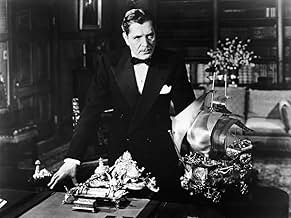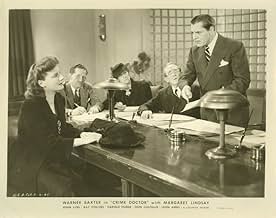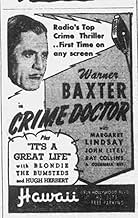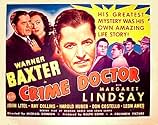Ajouter une intrigue dans votre langueAmnesia victim, Robert Ordway, becomes the country's leading criminal psychologist. After he is hit on the head by someone from his past, he suddenly remembers his previous life as a crimina... Tout lireAmnesia victim, Robert Ordway, becomes the country's leading criminal psychologist. After he is hit on the head by someone from his past, he suddenly remembers his previous life as a criminal.Amnesia victim, Robert Ordway, becomes the country's leading criminal psychologist. After he is hit on the head by someone from his past, he suddenly remembers his previous life as a criminal.
- Réalisation
- Scénario
- Casting principal
Phil Arnold
- Third Reporter in Court
- (non crédité)
Paul Bryar
- First Reporter in Court
- (non crédité)
Wallis Clark
- Judge
- (non crédité)
Chester Clute
- Headwaiter
- (non crédité)
Kernan Cripps
- Turnkey
- (non crédité)
Harold De Becker
- Bartender
- (non crédité)
Franklyn Farnum
- Juror
- (non crédité)
Avis à la une
One of the wilder premises involving a movie series was in the Crime Doctor films that starred Warner Baxter. We are asked to believe that Baxter was once gentleman crook Phil Morgan who held out the loot from his gang and who slugged him and threw him from a moving car and left him for dead. He didn't die, but has a case of amnesia. In any event ten years go by and in those ten years we are asked to believe that Baxter has acquired the eduction and training to become criminal psychologist Robert Ordway a most respected gent.
The Crime Doctor character came from radio and I assume that radio provided a lot of background so that the Ordway character became more believable. Given the fact that the movie-going public had been used to the Crime Doctor radio program the whole premise was easier to swallow in 1943 than it is today.
Baxter who is now a successful criminal psychologist and engaged to Margaret Lindsay is visited by old gang member John Litel who wants to know where the stashed loot is. He's not buying the amnesia story. He assembles the rest of the gang and the film is a battle of wits between Baxter and the rest. Need I tell you who wins?
Future Crime Doctor films gradually left out the part that Baxter was a convict and as a result they have not become as dated and are more believable than the first film. Some are actually pretty good with the simple premise that Baxter with his psychological training is a pretty good criminologist, better in many cases than those who carry a badge. In fact Jeff Goldblum's character on Law and Order: Criminal Intent who does carry a badge can trace his origins back to Warner Baxter's Robert Ordway.
A good screen character with too much unbelievable baggage.
The Crime Doctor character came from radio and I assume that radio provided a lot of background so that the Ordway character became more believable. Given the fact that the movie-going public had been used to the Crime Doctor radio program the whole premise was easier to swallow in 1943 than it is today.
Baxter who is now a successful criminal psychologist and engaged to Margaret Lindsay is visited by old gang member John Litel who wants to know where the stashed loot is. He's not buying the amnesia story. He assembles the rest of the gang and the film is a battle of wits between Baxter and the rest. Need I tell you who wins?
Future Crime Doctor films gradually left out the part that Baxter was a convict and as a result they have not become as dated and are more believable than the first film. Some are actually pretty good with the simple premise that Baxter with his psychological training is a pretty good criminologist, better in many cases than those who carry a badge. In fact Jeff Goldblum's character on Law and Order: Criminal Intent who does carry a badge can trace his origins back to Warner Baxter's Robert Ordway.
A good screen character with too much unbelievable baggage.
In the 1930s and 40s, Hollywood made a huge number of "B" detective series films. They were called "B" because they had lower budgets, were shorter than the average film and were meant to be the second film in a double feature--the lesser of the two films. In general, these films were a lot of fun to watch BUT they also were very formulaic and repetitive. I enjoy Sherlock Holmes, Charlie Chan, Boston Blackie and the Saint, but will gladly admit that once you've seen a few they all seem to blend together--particularly the Blackie series. It is because of this sameness that I really, really appreciate the Crime Doctor films--they are not so predictable and offer some nice innovations.
This movie is the first, and from what I've seen, the best of the Crime Doctor films. It sets the stage for future films by explaining how Warner Baxter became a psychiatrist and crime solver and is well-written and interesting throughout--even though this movie's plot isn't original--having been a variation on a film from 1936. The acting is very good and the film is played more seriously than the average film of the genre--with no goofy sidekick or stupid police investigator. And, frankly, this is a good thing as the others are clichés that just seem to permeate almost every B detective film. Give it a watch--it's very enjoyable and doesn't disappoint, as the characters behave intelligently and believably.
This movie is the first, and from what I've seen, the best of the Crime Doctor films. It sets the stage for future films by explaining how Warner Baxter became a psychiatrist and crime solver and is well-written and interesting throughout--even though this movie's plot isn't original--having been a variation on a film from 1936. The acting is very good and the film is played more seriously than the average film of the genre--with no goofy sidekick or stupid police investigator. And, frankly, this is a good thing as the others are clichés that just seem to permeate almost every B detective film. Give it a watch--it's very enjoyable and doesn't disappoint, as the characters behave intelligently and believably.
This was the opening chapter in the Crime Doctor series from Columbia, and as usual the first cut is the deepest. The other nine films veered from lightly sparkling to slightly insipid but all lovely to see - this one was strikingly thought provoking with many memorable scenes scattered throughout. Additionally the production values, acting and plots were of a consistently high standard, and basically Columbia allowed Warner Baxter a six year holiday with the filming of them to help him recover his dodgy health.
A man is tossed out of a moving car as one dead in 1932, turns out an amnesiac who is nursed back to good health by a good doctor who encourages him to become a good friend, good citizen and ultimately a good psychiatrist. He achieves all this by 1943, by which time his shady past is starting to catch up with him, 3 dumb guys eager to reclaim USD 200,000 stolen in his previous life. How it all unfolds and is resolved is as ingenious as the b picture format and the Hays Office could allow. Favourite bits: The 4 of them sitting round the table in Frankie's, all wondering what was going off; Margaret Lindsay almost too exquisite too watch here; Leon Ames, the violent patriot in prison for life then out in a twinkling; the trial of Phil Morgan and Robert Ordway.
It should be an incredibly rewarding 65 minutes to fans of this genre of film, if you find yourself unmoved by it my advice is don't bother with the rest and do yourself and the fans a favour.
A man is tossed out of a moving car as one dead in 1932, turns out an amnesiac who is nursed back to good health by a good doctor who encourages him to become a good friend, good citizen and ultimately a good psychiatrist. He achieves all this by 1943, by which time his shady past is starting to catch up with him, 3 dumb guys eager to reclaim USD 200,000 stolen in his previous life. How it all unfolds and is resolved is as ingenious as the b picture format and the Hays Office could allow. Favourite bits: The 4 of them sitting round the table in Frankie's, all wondering what was going off; Margaret Lindsay almost too exquisite too watch here; Leon Ames, the violent patriot in prison for life then out in a twinkling; the trial of Phil Morgan and Robert Ordway.
It should be an incredibly rewarding 65 minutes to fans of this genre of film, if you find yourself unmoved by it my advice is don't bother with the rest and do yourself and the fans a favour.
This film is much better than what one might expect, given the studio that made it and the other films of this type put out at the time. Warner Baxter was a good actor, the supporting cast is able, and the writing is taut, uncomplicated and well-done. Direction, lighting and photography are professional. In short, there are few, if any, faults, and the film is well worth a watch. Leon Ames makes an early appearance in a somewhat far fetched sequence involving the rehabilitation of a hardened, bitter convict, but this is a minor, minor flaw in an otherwise very well constructed film. As another reviewer wrote, there are, thankfully, no dumb cops or simple minded assistants, just a well thought out plot and good acting.
With the exception of the Rathbone and Bruce Sherlock Holmes series, this is quite possibly the best of the 'mystery' series of the 30s and 40s. The series begins with this movie as Phil Morgan, master criminal, is double crossed by his gang, beaten and dumped along a roadside. As a result, he suffers from amnesia. This movie, the first of the series, establishes The Crime Doctor's background, explains how and why he became a doctor (a psychiatrist, actually), head of the parole board and helped many convicts find the 'straight and narrow'.
The element that makes this movie and the series in general unique is that it relies on psychiatry and the tendencies of the mentally ill. They often tease you by inserting an obviously unbalanced person and although the plot may lead one to believe that person is the "perp" they may or may not be the actual "perp". Because psychiatry was relatively new and often misunderstood, it provided general insight to the subject. In many ways, the series has yet to become dated although the psychological concepts may appear to be fairly basic nowadays.
A series of factors make this movie series much more enjoyable than others such as The Lone Wolf, Boston Blackie or Bulldog Drummond. The first is the consistency. The quality of the stories in all ten movies remains high throughout the series where the stories of other series tend to deteriorate into standard potboilers after the studio has captured the audience's interest. Second, the same actor plays the lead character in all of the movies. Third, the quality of the supporting cast is exceptional throughout the series. Some of the more recognizable supporting cast includes John Litel, Ray Collins, Harold Huber, Barton MacLane, Jerome Cowan, Reginald Denny, Eduardo Ciannelli, Nina Foch, George Zucco, Ben Weldon, Hillary Brooke, William Frawley, Ellen Drew and last, but far from least, a very young Lois Maxwell who played Miss Moneypenny in at least 15 James Bond films.
However, over the six years the series was shot, one can easily see Baxter's health deteriorating.
The element that makes this movie and the series in general unique is that it relies on psychiatry and the tendencies of the mentally ill. They often tease you by inserting an obviously unbalanced person and although the plot may lead one to believe that person is the "perp" they may or may not be the actual "perp". Because psychiatry was relatively new and often misunderstood, it provided general insight to the subject. In many ways, the series has yet to become dated although the psychological concepts may appear to be fairly basic nowadays.
A series of factors make this movie series much more enjoyable than others such as The Lone Wolf, Boston Blackie or Bulldog Drummond. The first is the consistency. The quality of the stories in all ten movies remains high throughout the series where the stories of other series tend to deteriorate into standard potboilers after the studio has captured the audience's interest. Second, the same actor plays the lead character in all of the movies. Third, the quality of the supporting cast is exceptional throughout the series. Some of the more recognizable supporting cast includes John Litel, Ray Collins, Harold Huber, Barton MacLane, Jerome Cowan, Reginald Denny, Eduardo Ciannelli, Nina Foch, George Zucco, Ben Weldon, Hillary Brooke, William Frawley, Ellen Drew and last, but far from least, a very young Lois Maxwell who played Miss Moneypenny in at least 15 James Bond films.
However, over the six years the series was shot, one can easily see Baxter's health deteriorating.
Le saviez-vous
- AnecdotesRay Collins, who plays Dr. Carey in this film, is one of several actors who played the title character in the "Crime Doctor" radio series.
- ConnexionsFollowed by Crime Doctor's Strangest Case (1943)
Meilleurs choix
Connectez-vous pour évaluer et suivre la liste de favoris afin de recevoir des recommandations personnalisées
Détails
- Date de sortie
- Pays d’origine
- Langue
- Aussi connu sous le nom de
- Karanlık mazi
- Lieux de tournage
- Mulholland Drive, Hollywood Hills, Los Angeles, Californie, États-Unis(Establishing shot.)
- Société de production
- Voir plus de crédits d'entreprise sur IMDbPro
- Durée
- 1h 6min(66 min)
- Couleur
- Rapport de forme
- 1.37 : 1
Contribuer à cette page
Suggérer une modification ou ajouter du contenu manquant


































